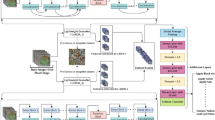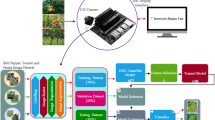Abstract
Leaf diseases are hazardous to the yield and quality of food crops. There are many deep learning algorithms developed for their detection that may require large computational resources to train a single model with voluminous amounts of data. In the agriculture domain, various plant diseases are found across the country. Accumulating such a huge dataset from various regions is a tedious task, and training them with a single model can also be challenging. This paper proposes Federated Deep Learning (FDL) for Plant Leaf Disease Detection. This concept allows multiple local models to get trained with their region-based datasets and share their knowledge with siblings through the parent, instead of sharing complete datasets. Knowledge transfer significantly reduces the computational costs. This paper formulates the federated dataset using PlantVillage, to simulate the configuration of the FDL. A lightweight and efficient Hierarchical Convolutional Neural Network (H-CNN) is proposed for parent model and child models with 0.09 million parameters and 0.35MB model size. The simulation results show that the proposed FDL attains 93% testing accuracy, outperforming state-of-the-art methods namely, FedAdam and FedAvg with 86.8% and 87.7% respectively. In addition to this, the proposed FDL achieves 95.7%, 95.4% and 95.3% of weighted precision, weighted recall and weighted F1-score respectively for first local model and 92.1%, 90.8% and 91.2% respectively of weighted precision, weighted recall and weighted F1-score respectively for second local model.








Similar content being viewed by others
Data Availability
The original dataset is available on following public domains: www.kaggle.com/datasets/lavaman151/plantifydr-dataset. However, the formulated federated dataset will be made available upon request.
Notes
References
Gao M, Zheng F, Yu JJ, Shan C, Ding G, Han J (2023) Deep learning for video object segmentation: a review. Artif Intell Rev 56(1):457–531
Shao Z, Han J, Marnerides D, Debattista K (2022) Region-object relation-aware dense captioning via transformer. IEEE Trans Neural Netw Learn Syst
Reddi S, Charles Z, Zaheer M, Garrett Z, Rush K, Konečnỳ J, Kumar S, McMahan HB (2020) Adaptive federated optimization. arXiv e-prints, 2003
McMahan B, Moore E, Ramage D, Hampson S, Arcas BA (2017) Communication-efficient learning of deep networks from decentralized data. In: Artificial intelligence and statistics, pp 1273–1282. PMLR
Palihawadana C, Wiratunga N, Wijekoon A, Kalutarage H (2022) Fedsim: Similarity guided model aggregation for federated learning. Neurocomputing 483:432–445
Patole R, Singh N, Adhikari M, Singh AK (2023) Multi-view ensemble federated learning for efficient prediction of consumer electronics applications in fog networks. IEEE Trans Consum Electron
Chen Y, Sun X, Jin Y (2019) Communication-efficient federated deep learning with layerwise asynchronous model update and temporally weighted aggregation. IEEE Trans Neural Netw Learn Syst 31(10):4229–4238
He C, Annavaram M, Avestimehr S (2020) Group knowledge transfer: Federated learning of large cnns at the edge. Adv Neural Inf Process Syst 33:14068–14080
Zubair Nafis KF, Maisha Tarannum S, Haque Charu K, Kabir Mehedi MH, Alim Rasel A (2023) Comparative analysis of federated learning and centralized approach for detecting different lung diseases. In: Proceedings of the 2023 9th international conference on computer technology applications, pp 60–66
Sarma KV, Harmon S, Sanford T, Roth HR, Xu Z, Tetreault J, Xu D, Flores MG, Raman AG, Kulkarni R et al (2021) Federated learning improves site performance in multicenter deep learning without data sharing. J Am Med Inform Assoc 28(6):1259–1264
Chen Y, Liang L, Gao W (2023) Dfedsn: Decentralized federated learning based on heterogeneous data in social networks. World Wide Web 1–24
Malik H, Anees T (2024) Federated learning with deep convolutional neural networks for the detection of multiple chest diseases using chest x-rays. Multimed Tools Appl 1–29
Uğuz S, Uysal N (2021) Classification of olive leaf diseases using deep convolutional neural networks. Neural Comput & Applic 33(9):4133–4149
Ferentinos KP (2018) Deep learning models for plant disease detection and diagnosis. Comput Electron Agric 145:311–318
Arun RA, Umamaheswari S (2023) Effective multi-crop disease detection using pruned complete concatenated deep learning model. Expert Syst Appl 213:118905
Yu H, Cheng X, Chen C, Heidari AA, Liu J, Cai Z, Chen H (2022) Apple leaf disease recognition method with improved residual network. Multimed Tools Appl 81(6):7759–7782
He K, Zhang X, Ren S, Sun J (2016) Deep residual learning for image recognition. In: Proceedings of the IEEE Conference on Computer Vision and Pattern Recognition, pp 770–778
Huang G, Liu Z, Van Der Maaten L, Weinberger KQ (2017) Densely connected convolutional networks. In: Proceedings of the IEEE conference on computer vision and pattern recognition, pp 4700–4708
Tan M, Le Q (2019) Efficientnet: Rethinking model scaling for convolutional neural networks. In: International conference on machine learning, pp 6105–6114. PMLR
Sandler M, Howard A, Zhu M, Zhmoginov A, Chen L-C (2018) Mobilenetv2: Inverted residuals and linear bottlenecks. In: Proceedings of the IEEE conference on computer vision and pattern recognition, pp 4510–4520
Singh RK, Tiwari A, Gupta RK (2022) Deep transfer modeling for classification of maize plant leaf disease. Multimed Tools Appl 81(5):6051–6067
Krizhevsky A, Sutskever I, Hinton GE (2017) Imagenet classification with deep convolutional neural networks. Communications of the ACM 60(6):84–90
Bhujel A, Kim N-E, Arulmozhi E, Basak JK, Kim H-T (2022) A lightweight attention-based convolutional neural networks for tomato leaf disease classification. Agriculture 12(2):228
Hari P, Singh MP (2023) A lightweight convolutional neural network for disease detection of fruit leaves. Neural Comput & Applic 35(20):14855:14866
Simonyan K, Zisserman A (2014) Very deep convolutional networks for large-scale image recognition. arXiv:1409.1556
Szegedy C, Vanhoucke V, Ioffe S, Shlens J, Wojna Z (2016) Rethinking the inception architecture for computer vision. In: Proceedings of the IEEE conference on computer vision and pattern recognition, pp 2818–2826
Szegedy C, Ioffe S, Vanhoucke V, Alemi A (2017) Inception-v4, inception-resnet and the impact of residual connections on learning. In: Proceedings of the AAAI conference on artificial intelligence, vol 31
Chollet F (2017) Xception: Deep learning with depthwise separable convolutions. In: Proceedings of the IEEE conference on computer vision and pattern recognition, pp 1251–1258
Liu Z, Mao H, Wu C-Y, Feichtenhofer C, Darrell T, Xie S (2022) A convnet for the 2020s. In: Proceedings of the IEEE/CVF conference on computer vision and pattern recognition, pp 11976–11986
Usha Ruby A, George Chellin Chandran J, Chaithanya B, Swasthika Jain T, Patil R (2024) Wheat leaf disease classification using modified resnet50 convolutional neural network model. Multimed Tools Appl 1–19
Thakur V, Nirupam S, Shalini V et al (2005) Present scenario of apple scab in various apple orchards of himachal pradesh. Hortic J 18(3):134–136
Ahmad M, Bhat M, Vennila S, Sardana H, Khare C (2015) Disease scenario of tomato in mid-hills and sub-tropical plains of India. Indian J Plant Protect 43(2):264–265
Bhat K, Peerzada S, Ali A et al (2015) Alternaria epidemic of apple in kashmir. Afr J Microbiol Res 9(12):831–837
Iqbal T, Altaf S, Dar JA (2019) Status of early blight [alternaria solani (ellis and martin) jones and grout] disease of tomato in kashmir. J Pharmacog Phytoch 8:2152–2154
Chasti F, Bhat NA, Rather RA, Nisar MU, Wani TA (2018) Severity of tomato late blight caused by phytophthora infestans (mont.) de bary in kashmir. Int J Curr Microbiol Appl Sci 7(10):3036–3047
Parihar C, Jat S, Singh A, Kumar RS, Hooda K, GK C, Singh D (2011) Maize production technologies in India
Lingwal S, Bhatia KK, Tomer MS (2021) Image-based wheat grain classification using convolutional neural network. Multimed Tools Appl 80(28):35441–35465
Stergiou KD, Psannis KE (2022) Federated learning approach decouples clients from training a local model and with the communication with the server. IEEE Trans Netw Serv Manag
Hassan SM, Maji AK (2022) Plant disease identification using a novel convolutional neural network. IEEE Access 10:5390–5401
Sun Y, Esaki H, Ochiai H (2020) Adaptive intrusion detection in the networking of large-scale lans with segmented federated learning. IEEE Open J Commun Soc 2:102–112
Sahu SK, Pandey M (2023) An optimal hybrid multiclass svm for plant leaf disease detection using spatial fuzzy c-means model. Expert Syst Appl 214:118989
Funding
First author, Pragya Hari receives the Phd scholarship from National Institute of Technology, Patna.
Author information
Authors and Affiliations
Corresponding author
Ethics declarations
Financial interest
There is no financial interests.
Conflict of interest/Competing interest
The authors declare that they have no conflict of interest/competing interests.
Additional information
Publisher's Note
Springer Nature remains neutral with regard to jurisdictional claims in published maps and institutional affiliations.
Rights and permissions
Springer Nature or its licensor (e.g. a society or other partner) holds exclusive rights to this article under a publishing agreement with the author(s) or other rightsholder(s); author self-archiving of the accepted manuscript version of this article is solely governed by the terms of such publishing agreement and applicable law.
About this article
Cite this article
Hari, P., Singh, M.P. & Singh, A.K. An improved federated deep learning for plant leaf disease detection. Multimed Tools Appl 83, 83471–83491 (2024). https://doi.org/10.1007/s11042-024-18867-9
Received:
Revised:
Accepted:
Published:
Issue Date:
DOI: https://doi.org/10.1007/s11042-024-18867-9




